International Journal of Structured Assocoation Technique No.1 pp.37-59
Treatment of Patients with Cancer for Stressful Emotion Transmitted from Ancestry by Using Genetic and Immunologic Data as Barometers
Kei-Ichiro Kobayashi*, Tsunetsugu Munakata**, Sayuri Hashimoto**, Takashi Hayashi***, Shigeko Sakamoto***, Miyo Hori***, Kazuo Murakami***, Ryoichi Obitsu**** (SAT Therapy Project, University of Tsukuba)
"Vivid Life" Counseling Room*, Department of Human Care Science, University of Tsukuba**,
International Science Promotion Foundation***, Obitsu Sankei Hospital****
Correspondence:
3-38-10 Miyoshi-Cho, Fuchu-City, Tokyo, 183-0045 Japan, "Vivid Life" Counseling Room
E-mail Address: k.-i.kob@jasmine.ocn.ne.jp
Abstract
Psychological scales are effective barometers of the memory of stress images in the therapeutic treatment of psychic symptoms like distress and depression. In the SAT imagery therapy to treat patients with cancer, however, their latent stress images are, except at the initial stages of therapy, hard to be revealed by psychological scales, owing to a personality known as the Type C behavior pattern in which a high degree of alexithymia is known to be common. When we treat the patient with cancer in the long run using the SAT imagery therapy, it required to adopt physiological data as barometers for their link with stress has been scientifically proved and also for they are affected neither by self-recognition of stress nor by consciousness. In this paper we introduce the two cases of health counseling for the patients with cancer in which adaptation of physiological data as barometers of stress image memories was proved effective. In the series of therapies, through the seasonal change of the physiological data, we have dealt with latent stress images connected to summer season. Our therapy has been conducted for about four years continuously, during which assessment has been made on the ratio of neutrophils, the ratio of lymphocytes, actual number of lymphocytes as barometers of immune strength and also the expression of four tumor-suppressor genes (p53, RB, BRCA2 and RUNX3) as barometers of genetic defensive force.
Key words: SAT imagery therapy, cancer, tumor-suppressor gene, immunity, seasonal change
1. Introduction
It is known that every day several thousands of cancer cells are generated in the body of a man who leads ordinary social life and that they are responded by immune strength to exclude non-self cells1). Under heavily stressful situation, the sympathetic nervous system holds dominant position in terms of the balance of autonomic nervous system, and the immune strength of lymphocyte, which are effective to destroy cancer cells, falls down, the number of active oxygen to wound tissues and genes is increased. When it lasts long, the cancer cells may be developed to cancer tissues2)3).
According to Temoshok, there is a common behavioral pattern to the patients with cancer dubbed a Type C behavioral pattern when cancer is taken as a stress disease4). Its traits are not to express negative feelings, to be persevering and to show self-sacrificing behavior. In terms of psychological scales used in SAT imagery therapy, it is characterized as high degree of alexithymia, strong self-restraining behavioral trait and weak problem solving behavioral trait. Often observed also are the cases of high degree of self-dissociation and self-compassion2). Among them all, commonly found is the case of high degree of alexithymia. In case these tendencies are remarkable, the patients are apt to make the stress latent for they do not recognize it as negative feeling. They do not tackle the stress practically, and they leave autonomic nervous system and hormone secretion unbalanced for a long time over 10 years. As a result they tend to make cancer appear as a somatic symptom.
Here exist two kinds of problems. The first one is the sensitivity to receive an external stimulus as a strong stress. The second one is the high degree of alexithymia, which prevents them from recognizing severe stress as own feelings. Both of these problems are caused by the past stress image memories and therefore the SAT imagery therapy using the image in the womb is effective. Cases treated by this therapy have been reported by Munakata and Kobayashi5)6)7). In these cases problems concerning psychological scales are solved with two or three times of therapies. After this stage, psychological scales are hard to be adopted as barometers of latent stress.
Psychological therapy is terminated at this stage because conscious distress and sense of depression are gone. In case of health counseling, however, because it deals with somatic symptoms caused by latent stress, continuous treatment becomes emphatically needed for latent stress, which does not reflected in psychological scales. Some latent stresses, transmitted from ancestors of generations ago, are hard to be realized. In addition, cancer patients in many cases select continuation of therapy at two-to-three month intervals in parallel with the observation of development of cancer even after the improvements of psychological scales. Therefore, it is needed to adopt as barometer of stress the physiological data whose high correlativity with stress have been scientifically proved, for they are affected by neither recognition nor awareness of stress. It is reported by Abo that the ratios of lymphocytes and neutrophils in a white blood cell are influenced by stress through the changes in the balance of autonomic nervous system8). Reported also by Munakata is that both ratios of lymphocytes and neutrophils show remarkable changes of more than 10 per cent when the patient receives a heavy stress due to the increase in tumor markers5). In addition, there is a report from the view point of genetic level that tumor suppressor genes of the patients with cancer are expressed by the use of SAT imagery therapy5)6)7).
Traumas accompanied with stress image memories in the past flash back when amygdala in cerebral limbic system recognizes the key situation common to the past scene and force to recognize an external stimulus as a heavy stress. When the key situation is conditioned as the factor like heat and coldness that is closely related with any particular season, traumas become sensitive to seasonal stimulus. However, in order to make a judgment if the subject stress is caused by seasonal factor or not, it is necessary to observe in the physiological data the reappearance of stress reaction in the same season for more than two consecutive years. The probability that the stress is caused by other factors cannot be excluded with the data only for one year, because urgent response to the true causes is required when the properties of cancer are taken into consideration.
In this paper therefore, we introduce necessity and efficacy of health counseling based on the physiological data, by introducing the cases in which we have continuously tackled the latent stress of the patients with cancer by observing seasonal changes in the ratios of lymphocytes and neutrophils, actual number of lymphocytes and also the degree of expression of such four kinds of tumor-suppressor genes as p53, BRCA2, RUNX3 and RB, which are closely related with cancer and can be measured scientifically as the immune strength and genetic defensive force.
2. Physiological Data & Stress
Most of human internal organs are controlled by autonomic nervous system and are influenced by the balance between sympathetic nerves and parasympathetic nerves. When, for instance, sympathetic nerves become advantageous with tension under heavy stress, the heart starts beating rapid. When parasympathetic nerves become advantageous with relaxation, the heart starts beating slow. When sympathetic nerves get excited, adrenaline as a neurotransmitter is secreted from the end of nerves and then the ratio of neutrophils that have adrenaline receptors increases. While on the other hand, the ratio of lymphocytes increases if parasympathetic nerves get excited due to the secreted acetylcholine8).
These changes are so rapid that they are noticeable even before and after a few hours of counseling. When cerebral limbic system and hypothalamus recognize the stress even without consciousness, therefore, the ratios of neutrophils and lymphocytes change. Thus, it enables us to adopt them as barometers of stress. At the same time, we measured the actual number of lymphocytes, which changed under the influence of the ratio of lymphocytes. The respective target value for each barometer was set, following Abo's report8), as follows; 51 to 57% for the ratio of neutrophils, 35 to 41% for the ratio of lymphocytes, not less than 2000/μl (primarily 1500/μl), and for the degree of relative expression of tumor suppressor genes not less than 200% in comparison with the pre-intervention value5)6)7).
As to tumor-suppressor genes, it is known that p53 and RB are found to have close relation between various kinds of cancer. Also BRCA2 and RUNX3 are reported to be closely connected with breast and stomach cancer, respectively9-12). It is advocated that we can connect these genes with psychological aspect based on the accumulated data. In SAT imagery therapy, the three basic needs of the soul that all of us human beings possess are defined as affection seeking demand, self-trust demand and affection for others demand3). In this regard, following correlations have been proposed; fulfillment of affection for others demands causes expression of p53, fulfillment of self-trust demands causes expression of RB, fulfillment of affection-seeking demands causes expression of BRCA2, and the prospects for obtaining fulfillment of the basic needs causes expression of RUNX32)13). In other words, we have stress when these demands are not fulfilled and therefore no prospect is obtained.
3. Methods of Research
Having explained scientific grounds of SAT therapy and some precedents to the patients of cancer who wish to receive it, we gave information on the assessment of genes. After obtaining their written consent, we started the therapy. As the data taken before the intervention were to be adopted as the standards for judging the subsequent data, we took blood for testing before and after the first therapy and measured the constituents of blood and tumor-suppressor genes therein. After the second therapy, we took blood for testing only after the therapy.
Psychological scales were checked before every therapy and each therapy was conducted based on these scales and the patient's chief complaint. After each therapy, we rechecked only the necessary items and assessed the efficacy of the ideal image obtained by the patient through the therapy.
The first few therapies were conducted at one to two week interval and at one-month interval thereafter. After the patient entered the stable stage, a few months interval was taken between each therapy in principle.
In this paper we introduce mainly the case of patient A in which latent stresses were solved by the continuous coping with seasonal changes of blood data, with patient B's case as a supplement. We will omit both the progression for the initial one year, because detailed reports are already available5)6). Since psychological scales of these patients have shown no problem after several times of therapy, the data of these scales are omitted in this paper. Thus, we will discuss only ratio of lymphocytes, that of neutrophils, number of lymphocytes and relative expression of tumor-suppressor genes all of which showed seasonal changes remarkably.
4. Patient A's Case
(1) Personal Background and Medical History
Patient A (32 years old, female) lost her mother and father by ovarian cancer in1996 and kidney cancer in 2002, respectively. Both her parents had operations and treatments with anticancer agents enduring side effects, but in vain. Particularly, her mother's painful appearance in the very last month left a strong impression on her.
When her father was two years of age, her grand mother on the father's side died. His stepmother showed favor only to her own children and was hard on the children of the former wife. After growing up, her father, together with half-brothers, ran a motor-mechanic factory, but he was dispirited surrounded by self-assertive stepmother and half-brothers. Patient A's mother also worked in this factory, but she as well as her husband was patiently enduring cruel tone of her mother-in-law and brothers-in-law. Having overstrained herself under such family and work circumstances, she miscarried in the first and second pregnancies. After she gave births to patient A's brother, patient A and younger brother, she became pregnant again. But this time she was obliged to undergo an abortion induced by her mother-in-law. In June 2006 patient A, for tumors of left mammary gland, had left pectoral-preserving mastectomy and axillary's lymph node dissection. Because patient A, based on her experiences to have lost her parents by cancer, does not believe that cancer is curable either with operations or with strong medicines, she refuses either anticancer agent or radiotherapy and is presently receiving treatment of SAT imagery therapy. At the starting of the therapy in January 2003, she wished as follows We heard her complaining as follows; "Because both my parents died of cancer, I am always tagged by anxiety of metastasis and reoccurrence of cancer no matter what I may do. Thus I am inclined to stay inside to my shell. Also, I think I am a natural worrier. I want to open my mind and become different. I want to change myself so that I may be satisfied even when I make a mistake."
(2) Summer Effect Revealed in Physiological Data
verall mental condition of patient A was improved only through a few times of SAT imagery therapy. After one year of the therapy, both the immune force judged from the ratios of lymphocytes and neutrophils and the genetic defensive force judged from expression of tumor-suppressor genes have been improved, as is reported earlier6). In the summer of the second year(2004), the ratio of neutrophils increased remarkably, at the same time the ratio of lymphocytes decreased as shown in Figure 1.
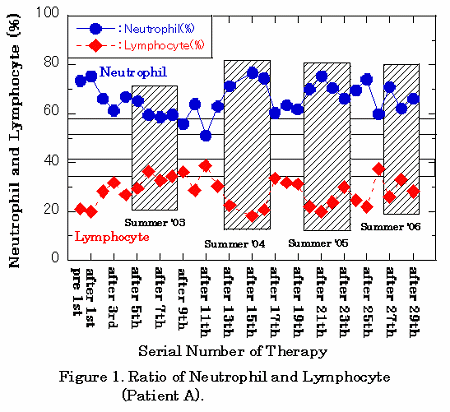
Especially, the number of lymphocytes showed a sharp decrease from favorable figure of over 2000/μl to 800/μl in a short period of time, as seen in Figure 2.
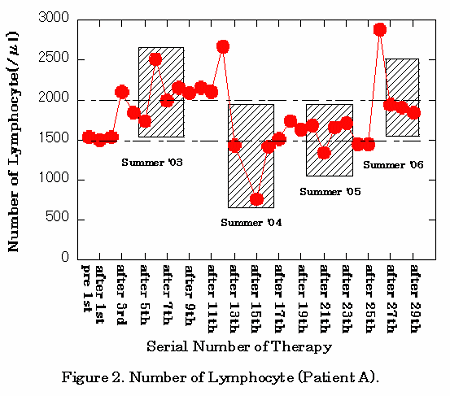
The expression of tumor suppressor genes also fell down in the same period as shown in Figure 3 & 4.
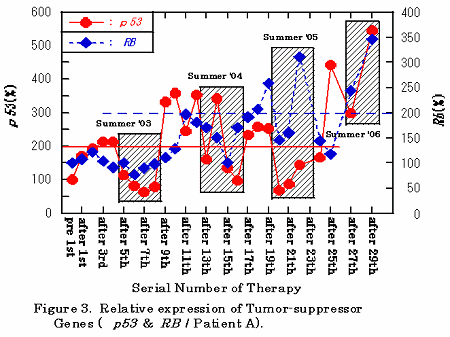
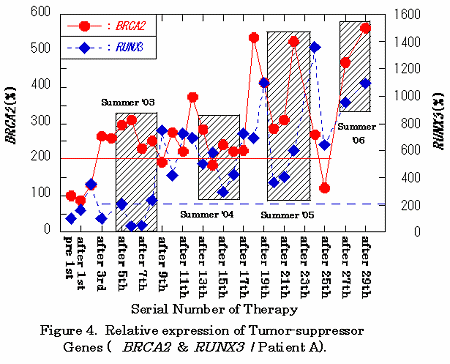
Such a trend was particularly remarkable in the 15th therapy held in mid-August. As a result, this trend was continuously observed from the 13th therapy in June to the 16th one at the end of September. By analyzing these physiological data up to this summer, similar tendency was also observed in tumor-suppressor genes in the summer of 2003, but it is not conclusive.
When we asked her the existence of any stressful experience that could be connected with summer or heat, she reminded five experiences all of that have happened in summer season. (1) She felt suffocative even in relatively mild summer in 2003, (2) her mother died of cancer in June, (3) She had an unforgettable impression of her mother's painful look for the previous month to the death, (4) her father died of cancer in September, (5) although she got furious to her uncle when he talked on the forthcoming funeral of her father in August when her father was getting worse, she suppressed her fury. When we compare this with the case of patient B which we will introduce next, the length of the decrease in physiological data is in good agreement with that of their stressful summer images.
(3) Treatment for the Feeling of Vital Crisis in Heat
We started tackling patient A's latent stress with suffocative feeling, that had been somatically expressed as a symptom under the key situation of summer. In the image in the womb derived from the fear (life-threatening) behind the suffocative feeling, life-threatening fear of both her and her mother were found. In the womb, since patient A could not move freely, she struggled so confusedly that she felt hot and suffocating with her neck entangled with the navel cord. By tracing back her genealogy using the emotions of life-threatening fear and impatience in the womb, a image of a mother, six generations back on the mother's side, was reminded, where this mother was weeping with a sense of guilt and sorrow for she had had a miscarriage.
At first, the image of this mother of six generations back was dealt with. Patient A found out a ideal image, where the mother of seven generations back told to her daughter (six generations back) "It is OK only if you do whatever you can do." Then, in the subsequent image, the mother of six generations back gave birth to a baby all right because she had not attempted to hold anything heavy beyond her power during pregnancy. By the therapy using the growing image of this baby, the baby boy in her image grew up to be a considerate man establishing a harmonious household while working as a farmer.
What was common to images of mothers of six to seven generations back and patient A in the womb was found out to be the miscarriage of babies. Since patient A's mother had miscarried two babies before she was born, patient A in the womb felt life-threatening fear and anxiousness that she also might be miscarried even when her mother had a slightest anxiety. She wondered, "If the first two babies had been born, was I ever born?" "Wasn't it good that I was born?" She felt sorry. At the same time she became aware that all the mother of seven generations back, six generations back, her own mother and herself had in common the way of life following the image script of trying to be accepted by working hard. When her mother had a slight anxiety, patient A amplified it and asked herself with a strong fear, "Am I not needed?" Also, she wondered, "Can't my mother work because of my being?" Since she felt that her mother shared the image script of trying to be accepted by working hard, she was afraid that her mother would not need her as an obstacle to her working. In order to be accepted by her mother therefore, patient A also worked hard following the same image script. It was the reason why her neck was entangled with the navel cord. Under these circumstances the heat was connected with the suffocative feeling in her mind, and she noticed that whenever it got hot suffocative feeling was regenerated.
As we made an ideal image into her ancestor's life, a new sense grew up in her that it was OK for her to be born. With this new sense, her mother's slight anxiety did not weigh on her mind any more. In the image of her being in the womb as well, she did not need to struggle confusedly any more and therefore, she did not feel hot any longer and she was not any longer troubled by the suffocative feeling caused by the entangled navel cord. At the end of this therapy she said her impressions as follows; "I was troubled with the illusory fear that I had invented myself with confusion. I think I'm OK now, breathing deeply, taking hold of myself and saying to myself that I am OK. Now I see that no problem can hurt me. For me it is more than enough just to be living."
With this 16th therapy the number of lymphocytes was increased from below 1000/μl up to the temporarily targeted level of 1500/μl and thus a crisis of immune strength was avoided (Fig. 2). The ratios of lymphocytes and neutrophils took turns to the recovering tendency (Fig. 1). Regarding expression of tumor-suppressor genes also, sharply declining tendency of p53 was stopped and both RUNX3 and RB took turns to an increasing tendency.
(4) Treatment for Father's Death in September
Patient A's physiological data showed a stable progress during the period from the autumn 2004 to the spring 2005. From the 20th therapy in May 2005, when her summer season was just starting, we re-started tackling her remaining stress images in order to prevent the re-descent of her physiological data. In the 20th therapy the images of her parents' deaths by cancer were taken up. First, we introduce our tackling of her father's death.
Patient A's father, who died in September 2002, had suffered from kidney stone 20 years before. So, it is suggested that he had been under stressful situation since then. By asking her father's situation at her age of 15 or so, it turned out that he actually was troubled with stressful circumstances. He, together with two half-brothers, ran a motor-mechanic factory, but he was troubled with the human relationship with his stepmother and half-brothers both in the work place and at home. One of his half-brothers had initially wanted to be a cook, but he was forced to give up his dream by his mother and he had no choice but to work in the factory. As a result, he became an alcoholic addiction and divorced his wife. His daughter also became mentally unstable to cause big troubles. The wages which this stepmother kept paying even to such a half-brother, who was unable to work, was a big financial difficulty for their family-owned motor-mechanic factory. Nevertheless, patient A's father could not start discussing this problem with the self-assertive stepmother, and had nothing to do but put up with it.
A new ideal image of stepmother was introduced, where she equally loves every brother and permitted elder half-brother's desire to be a cook. Consequently, his half-brothers and family environment were improved in her image; now Patient A's father was able to discuss important matters with her stepmother. She felt that her father, under such new circumstances, might suffered neither from kidney stone nor cancer 20 years later. When she phone-called to her father in the image, she heard him say, "Hi, why don't you come home once in a while?" After that, the sense of emptiness she had been feeling in September has vanished.
Patient A noticed that the sense of emptiness she had experienced before in September had been caused by her sense of powerlessness both to heal her father's loneliness due to his early loss of the real mother and to act as a substitute for her mother to console her father who had lost his wife by cancer. Since she noticed that she had wished to be accepted by performing beyond her ability, she came to positively judge the fact that she had been close with her father as his daughter enduring her pleasure. Consequently, she felt that she had done as much as she could.
(5) Treatment for Mother's Death in June
The mother's painful appearance for the last one month just before death was intensely imprinted in patient A's mind. Thus, in every May she had felt painful feeling and occasionally had tympanitis by complicating her cold. She also had been mentally affected by the worsened physical condition of a female patient with cancer who had a facial resemblance to her mother. In the successive 20th and 21st therapy conducted in May 2005, we tackled her stress connected with her mother's death.
While her mother was in a terminal stage of cancer, patient A was barely aware if she was awake or dormant. By dealing with her anxiety in those days, she reminded the relationship between her step-grandmother and her mother. Although the step-grandmother had praised her daughter-in-law (a wife of her own son) in front of patient A's mother, she had never praised patient A's mother, who had strongly wished to be accepted by her mother-in-law. She was also shocked by the words of her mother-in-law, "I never expect you and your husband to look after me." Actually, patient A's mother had a similar experience in her childhood. Her elder sister was so excellent that her mother often praised her. Patient A's grandmother loved patient A's mother, but this grandmother did not praise patient A's mother at all. So, patient A's mother grew up lacking in confidence. Patient A's mother, thus having grown up observing the relations between her mother and sister, felt so sad that she after marriage became very sensitive about her relations with the mother-in-law. She was so eager to be praised by her mother-in-law. Unfortunately however, her mother-in-law praised another daughter-in-law but her, and it upset her very much. As a matter of fact, patient A's stepgrandmother also in her childhood lost her mother and grew up lacking in maternal love. This fact had strongly influenced her character.
At this stage of therapy we introduced two new ideal images. The first one is the image in which patient A's grandmother on the mother's side praised all the children equally. The second one is the image in which the real mother of the stepgrandmother on the father's side lived long and her daughter grew up under an affectionate circumstances. Starting with these two new images, the problems regarding human relations in patient A's image were all solved. Patient A's mother, having grown up with her mother's praise, became confident, got free from trivial criticism from others, accumulated no stress and accordingly avoided suffering from cancer. Her mother, now in sixties, is still healthy in her image. As in the case of her father's image, when she phone-called to her mother in the image, she had a pleasant conversation such as "I'm enjoying myself just as usual" and "So am I." This conversation with the imaginary mother made her so happy that the oppressiveness she used to have in June has disappeared.
Having looked back at the therapy, patient A expressed her past feelings of oppressiveness in June as follows; "I had a difficulty to accept my mother's death. I had a faint feeling of being guilty for my mother's death. It was needed to look for the criminals to put the blame on somebody else in order not to distress myself. However, I hated myself looking for the criminals. Through the therapy I began to feel that my mother also had had a good time. She had lived her natural life, and must have been happy in her own way. By thinking like this, I have realized that my feeling of oppressiveness in June was gone."
Patient A had regarded her stepgrandmother on the father's side as the cause of the stress for her parents. Through the therapy, however, she found out an unexpected feeling in herself. She reminded that in her childhood this stepgrandmother had always protected her and taken her out for fun to various spots in behalf of her parents who had been too busy for their works to take care of her. After her mother got ill, however, she heard of the treatment that her mother had received from this stepgrandmother. As a consequence, she turned to consider this stepgrandmother as the criminal. In her mind, the image of this stepgrandmother changed from "the person I love" to "the person I should not love." She was forced to deny herself because she had felt favorably toward this stepgrandmother. According to her, it was the first time that she spoke "I love my grandmother." Until then, she had turned her eyes only toward sad matters. After she accepted it as a fact that her mother also had a happy time, she realized that it was not necessary to fix her position one-sidedly, to love or not to love the stepgrandmother. Since patient A realized this attitude, as regards the female patient who had a facial resemblance to her mother mentioned above, she has changed to less worry about that female patient's death because she realized that her happy feeling with the patient might remain even if the patient would die.
Having actively tackled the images transmitted from ancestors in addition to the re-growing imagery for patient A and her parents, we improved her stressful images connected with summer season. As a result, by comparing the physiological data in summer of 2005 and 2006 with those of 2004, we have successfully controlled the anticipated changes (Fig. 1, 2, 3 and 4). Actually the change is remarkable when we see the number of lymphocytes (Fig. 2). In summer 2006 further improvement has been observed compared with summer 2005. The degree of expression of tumor-suppressor genes as a whole showed an increasing trend. Both p53 and RB fell down to below 200% in the summer 2005, but in the summer 2006 all the four kinds including the above two maintained over 200% in the degree of expression. After the 29th therapy remarkable expression has been observed such as 550% of p53, 350% of RB, 560% of BRCA2 and 1100% of RUNX3. The number of lymphocytes in the summer 2006 was maintained around 2000(/μl). We had been conducting the SAT Retroactive Evolution Imagery Therapy for patient A since the 27th therapy, then its remarkable effects were observed particularly in the change of tumor-suppressor genes.
5. Patient B's Case
(1) Personal Background and Medical History
Patient B (46 years old, female) was born as the second daughter of two sisters. Her father was a safety-first and quiet man and her mother was an emotional and apt to condemn others. At the end of July 2001 cancer was discovered in her left breast. Since then, she underwent breast-conserving lumpectomy in August, three times of chemotherapy, 25 times of radiotherapy during September and hormone therapy by irradiation to the ovary. Listening to the lecture on SAT imagery therapy, she started in February 2003.
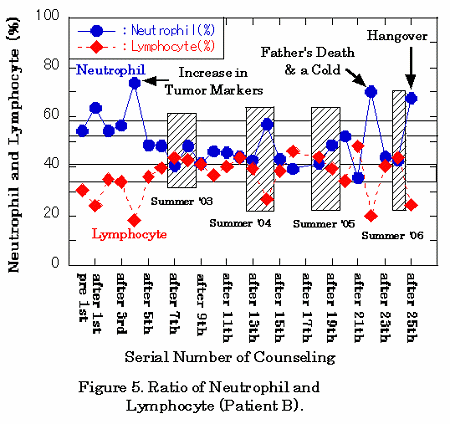
(2) Summer Seasonal Effects in the Case of Patient B
As is in the case of patient A, three to four times of therapy has improved patient B's psychological scales, that are signs of being conscious of stress feeling, and this condition has continued to the end of her therapy3). In her case, myelosuppression was remarkable as a result of treatments by anticancer agents and radiation. The number of white blood cells often showed a small figure remaining between 3000/μl and 5000/μl, which was within the standard though. Thus, before the intervention of SAT imagery therapy, the number of lymphocytes stayed as few as 1121/μl although the ratio of lymphocytes was 30.3%. By the therapy of over ten times during a year and half, the number of lymphocytes have increased to around 1500/μl and both the ratio of lymphocytes and neutrophils have been improved. The tumor-suppressor genes except for p53 were kept expressed condition of over 200%.
All the physiological data taken after 14th therapy, which was held in August 2004, showed a trend for the worse just like patient A's case. The ratio of neutrophils, which had been stable between 40 to 45%, went up to 57.2%. The ratio of lymphocytes, which had been around 35 to 40%, fell down to 26.7% (Fig. 5). At the same time as shown in Figure 6, the number of lymphocytes fell down to 1015/μl, the smallest value ever before. The degree of expression of four kinds of tumor-suppressor genes, which had been showing a favorable tendency, fell down sharply (Fig. 7, 8). Although we asked patient B if she had any experiences or physiological responses in the summer 2004 which are to cause these remarkably negative effects in physiological data, she had no idea. On the contrary, in the next therapy she talked to us her impression on the latest trip to abroad. She said as follows; "I'm not ill any longer. I'm OK for I am satisfied deep in my mind."
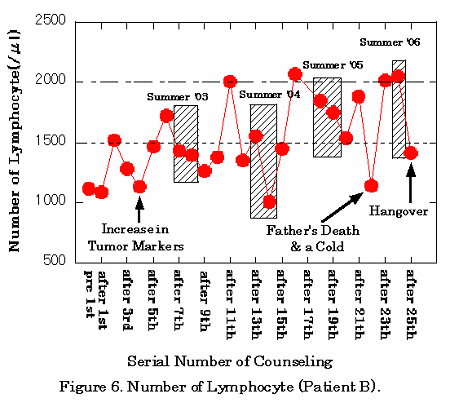
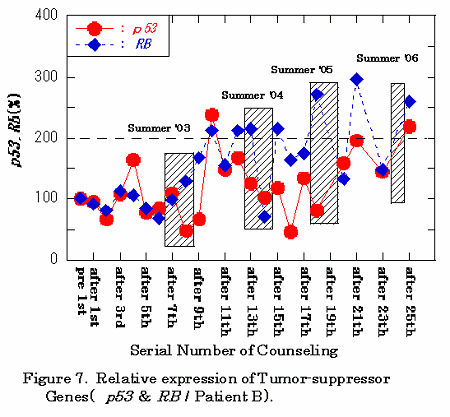
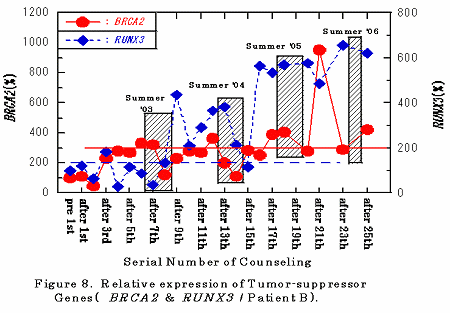
(3) Diagnosis and Second Opinion in summer season
At the 18th therapy in June 2005, based on the experience in the case of patient A, we started treatment assuming summer seasonal effects. By asking her again the existence of any summer seasonal trauma, severe trauma was found out.
On the next day of being told of her cancer in her left breast in July 2001, patient B visited a famous female doctor in the suburbs of Tokyo metropolitan area to obtain a second opinion. In the explanation prior to the CT scanning, this female doctor said, "Your days are 3 months if shadows are found by CT scanning," which was quite different from the words told the day before by the first doctor; "You are all right." Fortunately, no shadow was found in CT scanning. Nevertheless, the female doctor's words impressed her a very strong feeling of fear, as she said, "That word frightens me even now." Later in early August she underwent the operation. At the end of August, the results of the tissue test was told not to be malignant. She said, "For five weeks from the end of July till the end of August, I had a mentally hard time for the terror of death caused by that female doctor's words." She expressed her condition in those days in such other way, as "I was mentally abnormal losing all my senses including stiffness and pain in my body which I used to feel generally". This suggests that she was in a extreme fear of death. Patient B had been supposing it to be suspicious as a cause of her cancer that in her youth she enjoyed a fashion in light clothes and consequently had let her body get cold. Her inclination to such a fashion had stemmed from her mother's words in such an authoritative tone as "Never let your body get cold in such a light fashion."
As the ideal scene 1, we introduced the image of her avoiding the above reported five weeks in the ideal circumstances. We started with the image in which her mother had taught her affectionately and quietly how bad the light dressing would be for her health. Then in the new image she got into a habit of wearing one thing on top of another and not let her body get cold any longer even after coming of age. Although patient B actively works as an interpreter now, she used to be engaged in translation work at home before. She felt physically stressed because she did not like working at home, but she kept working as a translator due to her lack of confidence and fear of becoming an interpreter. In the newly introduced image, however, she had started working as an interpreter earlier and had no stress because she had grown up with the feeling of mother's constant love and obtained the self-confidence. If she had further continued this way of living, she would have got into a habit of wearing several layers of clothing even when she had actually worked in the air-conditioned room in the summer two years before her cancer was found out. The accumulation of all these images made it possible for her to feel that she must have avoided cancer.
As the ideal scene 2, following the scene 1 where the problem was resolved by externalizing the origin, we introduced the next image where, by internalizing the origin, patient B avoid the abnormal five weeks of fear by herself. We started with the image in her youth in which she would pay attention neither to her mother's words nor to speaking attitude but would change the subject of talk to something pleasant for herself. Then, her mother's look and speaking attitude would have changed, and an aggressive atmosphere would have disappeared, then she and her mother would have felt closer to each other. As a consequence of this ideal image, patient B would have sufficiently felt the meaning of her existence, patient B was able to change her job to an interpreter on much earlier stage and her body was freed from stress. Then, to that female doctor's second opinion, she would have felt "Is this true? I wonder if this doctor is overreacting." Then her shock was softened and her sense of spending ordinary hot summer has returned.
Getting back her sense of ease, as a matter of fact, patient B realized that her real problem was her perfectionism. She explained that since she had a strong belief such as "It should be nothing but a good cancer", she accepted various stimuli as much more fearful than as it is. By realizing this tendency of her own, patient B felt relaxed and was able to get rid of perfectionism. The image of the summer 2001 naturally changed to those, where environmental situation came in view of her, she could feel the heat spending pleasurable summer days chatting with her husband. Being asked about the foreseeing image of soon coming summer of 2005, she replied to us with a smile, "Just ordinary summer is coming, isn't it?" Since she no longer went after the perfection, patient B had felt relief.
By dealing with stressful summer images of patient B, we have successfully suppressed the getting worse of her physiological data in summer 2005 in comparison with that in summer 2004. In addition, in summer 2006, no influence was observed on immune strength, that is the number of lymphocytes was 2050 /μl, the ratio of neutrophils and lymphocytes are 43% and 44%, respectively. With regard to tumor-suppressor genes, all the four genes showed the degree of expression over 200% as 220% for p53, 260% for RB, 420% for BRCA2 and 620% for RUNX3.
6. Discussion
Through a series of SAT imagery therapy for over four years for two patients with cancer, we have solved latent stressful images showing no sign on the psychological scales. That was enabled by reading signs in the changes of blood data, correlation of which between stress had been scientifically proved.
Immune force and genetic defensive force showed rising trends in both two patients throughout four years. Except for immediately after the beginning of SAT imagery therapy, most of all the cases in which these data fell down have been explained in connection with such stressful images as; (1) summer seasonal effects in both cases of patient A and B, (2) mental shock by an increase in tumor marker in case of patient B at the 4th therapy5), (3) mental shock immediately after the death of her father and bad physical condition for a cold in case of patient B at the 22nd therapy and (4) a serious hangover in case of patient B at the 25th therapy. Patient B's mental shock at the 4th therapy has been caused by the increment of BCA225, one of the tumor markers for breast cancer assessed in the blood sample after the 3rd therapy, to the value slightly over the standard region. However, BCA225 value has returned back to the value within the standard region after the 4th therapy. This influence was observed on the changes of both immune strength and RUNX3 after the 4th therapy. On the contrary, since she knew the normalized value at the beginning of the 5th therapy, these physiological data after the 5th therapy also restored. This heavy mental stress of her in the 3rd therapy was strongly suppressed because she mentioned nothing concerning her shock of knowing the increment of BCA225. Since she considered "The reoccurrence of breast cancer means being hopeless," there must have existed the life-threatening fear behind it. She only expressed her emotion as a feeling of joy very heartily and loudly, knowing the normalized data at the beginning of the 5th therapy. This tells us the heaviness of her mental shock by the increase of tumor marker which might sign the reoccurrence of breast cancer. This strongly suppressed latent stress, in consequence, emerged on physiological data. Therefore, the latent stress that is not expressed in psychological data is expressed in physiological data like immune strength and genetic defensive force, it is possible for us to grasp it. By this research, SAT imagery therapy was proved to have the ability of improving the physiological data. In addition, it was also proved that the influence of seasonal effects upon physiological data was as remarkable as the above stated three factors listed from (2) to (4). This can be understood from the fact that the seasonal stress of patient A and B has originated from the image memories directly connected with the death of their parents and their own.
All the four types of tumor suppressor genes (p53, RB, BRCA2, RUNX3) of the both patients were expressed over 200% in 2006, and the improved state of their immune strength also has been maintained except for the above stated summer seasons when stressful affairs occurred to them. This period in 2006 coincides with that where we introduced the newly developed SAT evolution retrospective imagery therapy. When we review the progress of the therapy for these patients from the viewpoint of the development of SAT therapy techniques, it spread over the period during which we rapidly expanded the scope of objects of treatment to (1) the stress images of a few generations before, (2) the stress images intergenerationally transmitted from ancestors by going back to the past in the unit of generation, (3) the stress images transmitted from ancestors by going back to the past in the unit of eras and (4) the stress images transmitted from ancestors by going back to the past in the unit of evolution. Because cancer is a disease with non-self cells caused by the change of gene, when we cope with cancer by means of expressing tumor-suppressor genes, the physiological data viewed from such a perspective strongly suggests that it is effective to treat the intergenerationally transmitted stressful image memories particularly with evolution retrospective imagery skill.
Psychosomatic diseases including cancer stem from a personality of alexithymia which suppresses recognizing psychic symptoms. When we tackle such clients, psychological scales have a tendency to be effective only at the initial stages of the therapies. In order to keep treating their latent stress images in the following stages, therefore, it is essential to (1) pick out the stress in their physiological data which are free from the influence of alexithymia, (2) find out the origin of intergenerationally transmitted emotion by letting them go back to the past from the present stress images to the ones of the past generations via their image in the womb and (3) support their self-growth through changing the image of the origin of their stress15).
References
- Obitsu, R. (Ed.) (2005). Encyclopedia of Home Care for Cancer. Futami Shobo, Tokyo, 228-231.
- Munakata, T. (2005). Caring Therapy to Save the Family with Patients of Cancer and Depression. Shufu-to-Seikatsu-Sha, Tokyo, 142-143, 149-157.
- Munakata, T. (2006). SAT Therapy. Kaneko Shobo, Tokyo, 102-119.
- Temoshok L., & Dreher H. (1992). The Type C Connection - The Behavioral Links to Cancer and Your Health. Random House.
- Munakata, T., Kobayashi, K.I., Hashimoto, S., Maeda, T., Hatsuya, T., Shoji, S., Obitsu, R., Kakui, S., Okubo, Y., Hayashi, T., & Murakami, K. (2004). Manifestation of Tumor Suppressor Genes by SAT Imagery Therapy. Kaneko Shobo, Tokyo, 57-71.
- Munakata, T., Kobayashi, K.I., Hashimoto, S., Maeda, T., Hatsuya, T., Kakui, S., Okubo, Y., Mochida, M., Hayashi, T., Obitsu, R., Shoji, S., & Murakami, K. (2004). A Case of Breast Cancer Patient in Which Activation and Immune Strength of Tumor Suppressor Genes Were Improved with the Application of SAT Imagery Therapy, Annual Report Vol. 10 of AHC, 61-67.
- Kobayashi, K.I., Hashimoto, S., Hayashi, T., Sakamoto, S., Hori, M., Obitsu, R., Murakami, K., & Munakata, T. (2006). Treatment for Stressful Emotion Transmitted from Ancestry of Patients with Cancer by Using Genetic and Immunologic Data as Barometers, Annual Report Vol. 12 of AHC, 37-45.
- Abo, T. (2001). Illness Caused by Medical Treatment. Iwanami Shoten, Tokyo, 1-51, 203-231.
- Niitu, Y., & Yokota, J. (Ed) (1999). Oncogenes and tumor Suppressor Genes - for Clinicians. Nanko-Do, Tokyo, 13-45.
- Itoh, K., & Nomura, S. (2006). Onset and Progress of Gastric Cancer Caused by Insufficient Manifestation of RUX3 , The Cellular Engineering, Vol. 21 No. 6, 646-647.
- Balmain A. (2002). New-age tumor suppressors. Nature, 417, 235-237.
- Miyagawa, K. (1998). BRCA1 and BRCA2. The Department of Hematology and Oncology, Vol. 36 No. 3, 227-223.
- Obitsu, R. (Ed.) (2005). Encyclopedia of Home Care for Cancer. Futami Shobo, Tokyo, 435-437.
- Munakata, T. (December, 2005). Materials for Health Counseling SOM Seminar.
- Munakata, T., & Kobayashi, K.I. (2007). SAT Imagery Therapy for Cancer. Shunju-sha, Tokyo, 44-68.